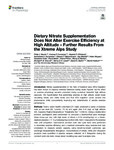Dietary Nitrate Supplementation Does Not Alter Exercise Efficiency at High Altitude – Further Results From the Xtreme Alps Study
| dc.contributor.author | Hennis, PJ | |
| dc.contributor.author | Cumpstey, AF | |
| dc.contributor.author | O’Doherty, AF | |
| dc.contributor.author | Fernandez, BO | |
| dc.contributor.author | Gilbert-Kawai, ET | |
| dc.contributor.author | Mitchell, K | |
| dc.contributor.author | Moyses, H | |
| dc.contributor.author | Cobb, A | |
| dc.contributor.author | Meale, P | |
| dc.contributor.author | Pöhnl, H | |
| dc.contributor.author | Mythen, MG | |
| dc.contributor.author | Grocott, MPW | |
| dc.contributor.author | Levett, DZH | |
| dc.contributor.author | Martin, Daniel | |
| dc.contributor.author | Feelisch, M | |
| dc.date.accessioned | 2022-04-04T12:16:20Z | |
| dc.date.issued | 2022-02-28 | |
| dc.identifier.issn | 1664-042X | |
| dc.identifier.issn | 1664-042X | |
| dc.identifier.other | 827235 | |
| dc.identifier.uri | http://hdl.handle.net/10026.1/18989 | |
| dc.description.abstract |
<jats:sec><jats:title>Introduction</jats:title><jats:p>Nitrate supplementation in the form of beetroot juice (BRJ) ingestion has been shown to improve exercise tolerance during acute hypoxia, but its effect on exercise physiology remains unstudied during sustained terrestrial high altitude exposure. We hypothesized that performing exercise at high altitude would lower circulating nitrate and nitrite levels and that BRJ ingestion would reverse this phenomenon while concomitantly improving key determinants of aerobic exercise performance.</jats:p></jats:sec><jats:sec><jats:title>Methods</jats:title><jats:p>Twenty seven healthy volunteers (21 male) underwent a series of exercise tests at sea level (SL, London, 75 m) and again after 5–8 days at high altitude (HA, Capanna Regina Margherita or “Margherita Hut,” 4,559 m). Using a double-blind protocol, participants were randomized to consume a beetroot/fruit juice beverage (three doses per day) with high levels of nitrate (∼0.18 mmol/kg/day) or a nitrate-depleted placebo (∼11.5 μmoles/kg/day) control drink, from 3 days prior to the exercise trials until completion. Submaximal constant work rate cycle tests were performed to determine exercise efficiency and a maximal incremental ramp exercise test was undertaken to measure aerobic capacity, using breath-by-breath pulmonary gas exchange measurements throughout. Concentrations of nitrate, nitrite and nitrosation products were quantified in plasma samples collected at 5 timepoints during the constant work rate tests. Linear mixed modeling was used to analyze data.</jats:p></jats:sec><jats:sec><jats:title>Results</jats:title><jats:p>At both SL and HA, plasma nitrate concentrations were elevated in the nitrate supplementation group compared to placebo (<jats:italic>P</jats:italic> &lt; 0.001) but did not change throughout increasing exercise work rate. Delta exercise efficiency was not altered by altitude exposure (<jats:italic>P</jats:italic> = 0.072) or nitrate supplementation (<jats:italic>P</jats:italic> = 0.836). V̇O<jats:sub>2</jats:sub>peak decreased by 24% at high altitude (<jats:italic>P</jats:italic> &lt; 0.001) and was lower in the nitrate-supplemented group at both sea level and high altitude compared to placebo (<jats:italic>P</jats:italic> = 0.041). Dietary nitrate supplementation did not alter other peak exercise variables or oxygen consumption at anaerobic threshold. Circulating nitrite and S-nitrosothiol levels unexpectedly rose in a few individuals right after cessation of exercise at high altitude.</jats:p></jats:sec><jats:sec><jats:title>Conclusion</jats:title><jats:p>Whilst regularly consumed during an 8 days expedition to terrestrial high altitude, nitrate supplementation did not alter exercise efficiency and other exercise physiological variables, except decreasing V̇O<jats:sub>2</jats:sub>peak. These results and those of others question the practical utility of BRJ consumption during prolonged altitude exposure.</jats:p></jats:sec> | |
| dc.format.extent | 827235- | |
| dc.format.medium | Electronic-eCollection | |
| dc.language | eng | |
| dc.language.iso | en | |
| dc.publisher | Frontiers Media | |
| dc.subject | exercise | |
| dc.subject | high altitude | |
| dc.subject | hypoxia | |
| dc.subject | nitric oxide | |
| dc.subject | beetroot | |
| dc.subject | nitrite | |
| dc.subject | nitrate | |
| dc.title | Dietary Nitrate Supplementation Does Not Alter Exercise Efficiency at High Altitude – Further Results From the Xtreme Alps Study | |
| dc.type | journal-article | |
| dc.type | Journal Article | |
| plymouth.author-url | https://www.webofscience.com/api/gateway?GWVersion=2&SrcApp=PARTNER_APP&SrcAuth=LinksAMR&KeyUT=WOS:000772859600001&DestLinkType=FullRecord&DestApp=ALL_WOS&UsrCustomerID=11bb513d99f797142bcfeffcc58ea008 | |
| plymouth.volume | 13 | |
| plymouth.publication-status | Published online | |
| plymouth.journal | Frontiers in Physiology | |
| dc.identifier.doi | 10.3389/fphys.2022.827235 | |
| plymouth.organisational-group | /Plymouth | |
| plymouth.organisational-group | /Plymouth/Faculty of Health | |
| plymouth.organisational-group | /Plymouth/Faculty of Health/Peninsula Medical School | |
| plymouth.organisational-group | /Plymouth/REF 2021 Researchers by UoA | |
| plymouth.organisational-group | /Plymouth/REF 2021 Researchers by UoA/UoA01 Clinical Medicine | |
| plymouth.organisational-group | /Plymouth/Users by role | |
| plymouth.organisational-group | /Plymouth/Users by role/Academics | |
| dc.publisher.place | Switzerland | |
| dcterms.dateAccepted | 2022-01-18 | |
| dc.rights.embargodate | 2022-4-5 | |
| dc.identifier.eissn | 1664-042X | |
| dc.rights.embargoperiod | Not known | |
| rioxxterms.versionofrecord | 10.3389/fphys.2022.827235 | |
| rioxxterms.licenseref.uri | http://www.rioxx.net/licenses/all-rights-reserved | |
| rioxxterms.licenseref.startdate | 2022-02-28 | |
| rioxxterms.type | Journal Article/Review |


